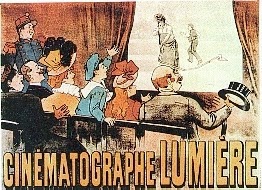On today's date, March 22 in 1895 the first public exhibition of a motion picture was given in Paris. It was a brief film, less than a minute, but it showed the world a new way to view photography and pointed the way to the future.
The Lumière Brothers
Auguste Marie Louis Nicolas (1862-1954) and Louis Jean (1864-1948) Lumiere were two of the earliest filmmakers in history of the medium (Interestingly, “lumière” translates as “light” in English).
Born in Besançon, France, both boys were good students in their youth, although the education of young Louis was frequently interrupted by terrible headaches. But at home he pursued an artistic education which included drawing and sculpture. Both boys attended La Martiniere, which was the largest technical school in Lyon. Their father, Antoine was the owner of a photographic company, and both of the brothers worked for him. Louis, working as a physicist developed a new apparatus for the mechanized production of photographic gelatin dry-plates, which eliminated the need for plates to be stored in a darkroom. This made photography much more convenient and made Lumière & Sons into a major company in Europe by 1900.
Papa Lumiere Comes Back From the U.S. With an Idea....
In 1894, their father returned from a trip to America thrilled with a new invention he had seen: a Kinetoscope, which had been developed by Thomas Edison. The Kinetoscope (right) was a device which created the illusion of motion pictures by projecting light through a series of rapidly moving photographic images. The Kinetoscope's images were viewed through a small peephole in the top of the machine, and their father suggested that they come up with a way of projecting such images onto a larger screen. Auguste tried for some time to develop just such a camera and a projection system, but without any success. But then Louis came up with the suggestion of using a mechanism like that used in a sewing machine to advance the cloth step by step.
The Lumiere Brothers Make it Work
The resulting product was a machine patented in France in 1895 in the name of the two brothers, which was constructed by their engineer Charles Moisson. The mechanism combined camera, projector and printer functions. The perforated film was moved intermittently by a
claw pulldown - a pair of pins which fit into the perforations on both sides of the film and then moved down, moving the film along with them. This motion film mechanism (left) was the used not only for the Lumière's machine, but forms the basis for such systems down to the present day. A number of test films were made in the early part of 1895. For the larger projection, the machine was placed on a wooden stand using an electric arc lamp. And the first public exhibition of this new system was made on today's date for the Society for the Promotion of Industry. There was only the one feature for this event: a brief little scene of 45 seconds, filmed by
Louis of workers as they left the Lumaire's own factory in Lyon which is called "La Sortie de l'Usine Lumière à Lyon" (which can be seen by clicking on those words). This new system caused considerable excitement at the time with movie posters (above) being produced to advertise this wondrous new novelty. And this, of course lead directly to the future -- the many films which we enjoy today.
Sources:
http://www.victorian-cinema.net/louislumiere
http://www.nndb.com/people/388/000212749/
http://gaukartifact.com/2013/03/05/the-lumiere-brothers/
http://en.wikipedia.org/wiki/Auguste_and_Louis_Lumi%C3%A8re
http://en.wikipedia.org/wiki/Kinetoscope





No comments:
Post a Comment